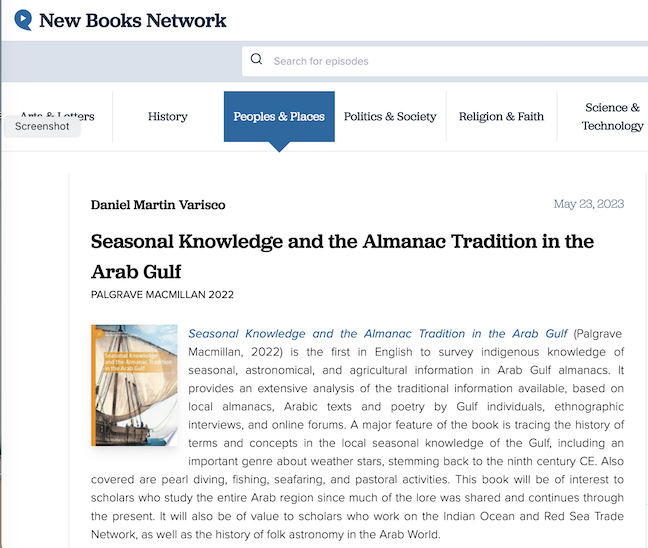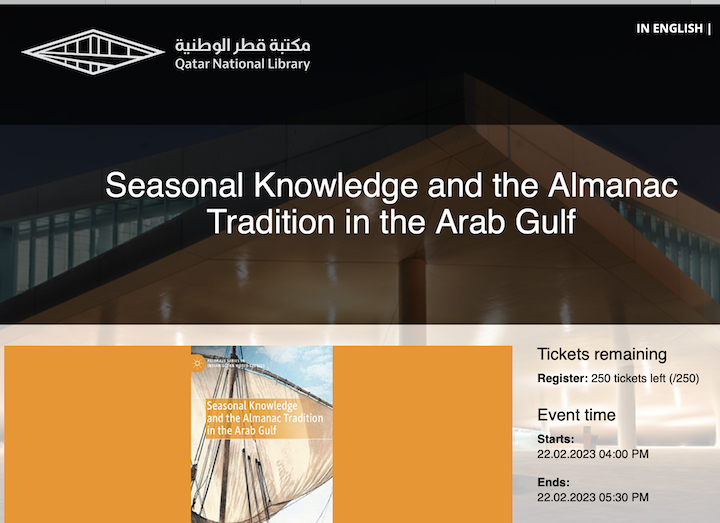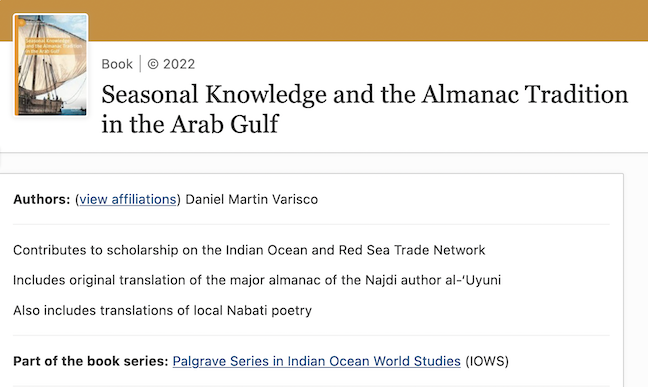
My podcast with Ahmed AlMaazmi and Tamara Fernando is posted online on the New Books Network.

My podcast with Ahmed AlMaazmi and Tamara Fernando is posted online on the New Books Network.
I will be giving a book launch on my recent book on Gulf almanac lore via Zoom for the Qatar National Library on February 22, 2023. Details about registering for the talk are provided at https://events.qnl.qa/event/opOp5/EN. Please feel free to spread word of the talk. Details on the book are at:https://link.springer.com/book/10.1007/978-3-030-95771-1.

I am pleased to announce the publication of my new book: Seasonal Knowledge and the Almanac Tradition of the Arab Gulf. Details about the book, including a free online pdf of the table of contents can be obtained here: https://link.springer.com/book/10.1007/978-3-030-95771-1

Below is the start of the Introduction…
Before the middle of the twentieth century, everyday life in the Arab Gulf was oriented to the sea and the land. Along the coast and for the island of Bahrain there had been a thriving pearl diving industry until the 1920s, while fishing remained one of the most important food production activities. Trade around and beyond the peninsula was still largely carried out by traditional dhows. Apart from Oman, which has a long tradition of irrigated and rainfed agriculture, most of the Gulf states faced a harsh, arid environment with limited water and only a few fertile oases. Herding of camels, sheep and goat was one of the main ways of surviving in the arid areas. It should not be surprising that prior to the oil wealth that created a lush economic transformation, the main topic of concern was the weather. Successful navigation, pearl diving and fishing required an intimate knowledge of seasonal change, as did pastoralism and farming.
Information on the seasonal sequence for the Arabian Peninsula stems back over a thousand years in collections of poetry, star lore and almanacs. One of the most important Arabic texts is the Kit?b al-Anw?’ (Book of Weather Stars) of Ibn Qutayba (d. 276/879), who is quoted by almanac compilers in the Gulf to this day. Ibn Qutayba describes in detail local knowledge about star risings and settings, weather seasons, pastoral activities, agriculture and a range of environmental conditions. Unfortunately, much of this indigenous heritage has disappeared, as the folklore of generations is now rarely passed on orally within families. In recent years older individuals in the Gulf have written memoirs, preserving their knowledge of life before the Petro Utopia. This gives us a glimpse of the past, a puzzle with many missing pieces, but not the full understanding that comes with actual contact.Resurrecting the history of seasonal knowledge in the Arab Gulf and the entire Arabian Peninsula thus requires a textual archaeology. It is not enough to simply document what is written, as though one is showing off museum objects; this knowledge needs to be placed into a lived context to have a better understanding of how people went about their lives off the land and on the sea.
The past is like an ocean in which we can sample only a small part of the vast number of ideas and customs that have passed by over the years. To follow this metaphor, most of our sampling is along the shore, learning from individuals we can ask directly or engage with in ethnographic fieldwork. We can only cast our research net a short distance in trying to reach back into what really happened and was said in the past. A historian can sail as well, dropping an anchor where there seems to be something worth exploring. But there are depths in this ocean of knowledge that can never be reached. There are also reefs, barriers that make it difficult to have smooth sailing through our disciplined search for the past. To what extent can we know what local knowledge was shared? Then there is the question of what kind of fish we are trying to catch. Is everything that has been done and said, no matter how many generations back, something we should call “heritage”? If we read about it in a book, even one written centuries ago, does that automatically make it “heritage”? How can we vouch for the accuracy of what has been written down when we cannot see it for ourselves or question the interpreter? These are not insurmountable hurdles, but they do caution us to recognize the limitations of reconstructing the past.
My career as a scholar began in the highland mountains of Yemen, where I carried out ethnographic research on traditional water resource use and local agriculture in the late 1970s. Talking with farmers and observing their work for over a year allowed me to gain an understanding of local practices that no book could give me. While in the field I had access to a fourteenth century Yemeni agricultural text, which described many of the agricultural activities I was seeing for myself. My first book was an edition and translation of a thirteenth century Yemeni agricultural almanac. Over the years I have become what is best called a historical anthropologist, someone who looks at heritage as a product evolving from a past and not simply what one sees, without hindsight, functioning in the present. As an anthropologist I focus on the diversity of what people do and say, giving voice to them rather than plugging them into an outside theoretical package from the start. As a historian I have an opportunity in examining texts to see the strands of past knowledge that survive and still influence the present.

In April Secretary-General Antonio Guterres called the situation in Yemen the world’s worst humanitarian crisis. After more than three years of a lopsided war between a Western-supported Saudi/Emirati coalition and a rebel group in control of the capital Sanaa and most of the estimated 28 million Yemenis, the crisis is only getting worse.
Now coalition forces are attempting to wrest control of the vital port of Hodeidah from the Huthi forces, thinking that such a loss would force the Huthis to accept their terms for a total submission. Since this port supplies most of the food and aid entering Yemen, loss of the port would likely trigger a siege to literally starve the Huthi areas into submission. The Huthis know this and are not likely to give up the port without a bloodbath. Meanwhile several hundred thousand residents fear for their lives and many have already fled to areas with no resources whatsoever. The UN fears a renewed outbreak of cholera, which has already affected more than one million Yemenis. Negotiations continue by the UN Special Envoy Martin Griffiths to stop the impending violence.
But in the midst of all this turmoil, one recent pundit argues that the eastern province of Marib, firmly in control of the Saudi/Emirati alliance, shows how one province succeeds in the midst of Yemen’s war. Not only is this sparsely populated and oil-rich area considered a success, it is said to be “thriving.” A football stadium with German turf and according to FIFA standards is being constructed and there is a new university for 5,000 students. The biblical land of the Queen of Sheba and famous Marib dam mentioned in the Quran (which was bombed at one point by the Saudis) is said to be “regaining a slice of its historical importance.”
So what is the lesson for Yemen’s future from this miracle in the desert? For journalist Adam Baron “Marib’s experience holds wider lessons for Yemen’s future: embracing decentralisation, empowering local actors, and focusing on ground-up stabilisation are all strands of the story that international and local players interested in bringing peace and stability to Yemen should note.” The main local actor here is a tribal sheikh named Sultan Arada, drawing on support of the conservative Islah movement. With outside money pouring in, he has morphed into the sultan of a fiefdom. The current “stability” is grounded not on local concerns but from the top-down flow of money from the neighboring international players, Saudis and Emiratis.
Yemen’s future is not in Marib, nor in building state-of-the-art FIFA stadiums in a country with a ravaged infrastructure, ongoing water crisis and sectarian violence fueled by the grueling three years of war. Marib is currently a colony of the Saudis, just as the Emiratis would like to take control of the island of Socotra and the port of Aden. The two wealthiest states of the now moribund GCC are carving out their zones of influence on the backs of people in the poorest country in the Arabian Peninsula. Without the billions of dollars worth of weapons and strategic intelligence from the West, this war dividend could never have been realized.
Welcome to the latest, post-Cold War twist in the land once thought to be Holy. It is no longer direct Western intervention but a shared geocolonialism, in which the proxy war between Saudi Arabia and Iran is applauded and abetted by Western leaders. Muhammad bin Salman’s recent trip to the U.S. sold his snake-oil reform in exchange for buying more weapons and all that he assumes oil-drenched money can buy. Meanwhile the Saudi abysmal track record on human rights and the war crimes of the Saudi-led coalition in Yemen are ignored. If Marib is the model for Yemen’s future, then the only democracy, for its flaws, in the Arabian Peninsula will be geocolonized into yet another make-believe kingdom or emirate.
This is to note that I have received a research grant from the Qatar Foundation for a study of indigenous knowledge of the seasons and time-telling in the Gulf. I have created a separate webpage to indicate progress through updates on the progress. This page is at https://tabsir.net/?page_id=2903
For those interested in the issue, the recently published July issue of International Sociology (30:4) is devoted to the Arab uprisings. It includes articles on the relations of revolution to such various dimensions as space, cultural symbols, microdynamics of mobilization, political Islam, and current scholarship:
Contents
Mohammed Bamyeh and Sari Hanafi, “Introduction to the special issue on Arab uprisingsâ€
Atef Said, “We ought to be here: Historicizing space and mobilization in Tahrir Squareâ€
Zaynab El Bernoussi, “The postcolonial politics of dignity: From the 1956 Suez nationalization to the 2011 Revolution in Egyptâ€
Hatem M Hassan, “Extraordinary politics of ordinary people: Explaining the microdynamics of popular committees in revolutionary Cairoâ€
Mazhar al-Zo’by and Birol BaÅŸkan, “Discourse and oppositionality in the Arab Spring: The case of the Muslim Brotherhood in the UAEâ€
Nada AlMaghlouth, Rigas Arvanitis, Jean-Philippe Cointet, and Sari Hanafi, “Who frames the debate on the Arab uprisings? Analysis of Arabic, English, and French academic scholarshipâ€

For my post on the Arab youth views of democracy, click here.